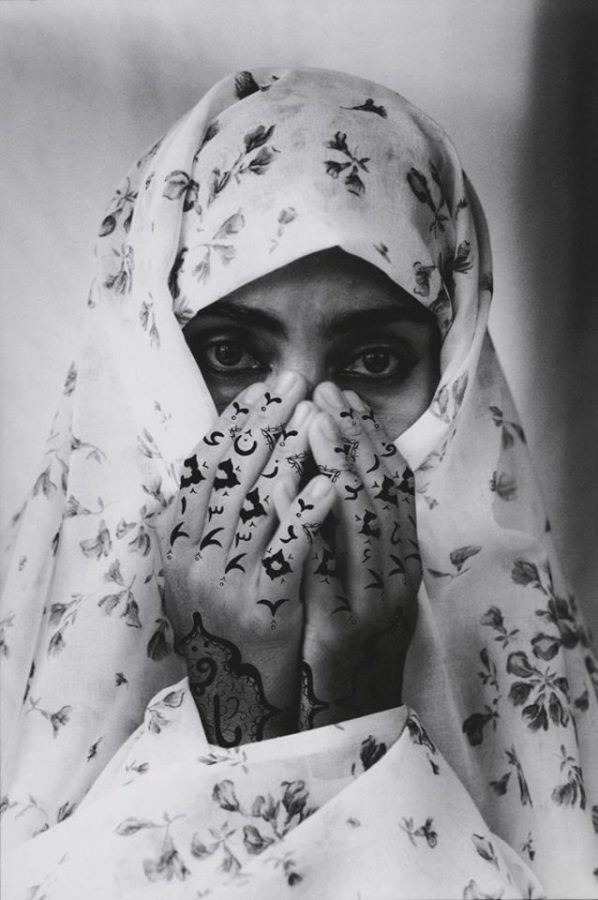“She Who Tells A Story” challenges Western preconceptions of Arab women
June 10, 2015
In the Heinz Galleries at the Carnegie Museum of Art, a black and white photo by Shirin Neshat depicts a woman’s hand over her closed mouth.
The words of Forough Farrokhzad, one of the most influential woman writers of the Iranian Revolution, are written in Persian script over her hand. What initially looks like a gesture of silence is actually a powerful reminder that Iranian women are far from voiceless.
That sentiment describes the motivation behind the exhibit, “She Who Tells a Story,” which translates to “rawiya” in Arabic. The exhibit is curated by Kristen Gresh, who is the assistant curator of the Estrellita and Yousuf Karsh Gallery at the Museum of Fine Arts, Boston. The exhibit features works from 12 women photographers from Iran and the Arab world and encourages visitors to write their reflections. Visitors’ messages — ranging from simple “I enjoyed this exhibit” to longer, more emotional gratitudes — are then tacked onto a large bulletin board that becomes part of the art as well.
The exhibit opened in Boston in August 2013 and will conclude its public run in Pittsburgh on Sept. 28, 2015. It will not show at other museums after its Pittsburgh appearance.
The Carnegie Museum of Art and organizations such as City of Asylum, an organization that provides refuge for exiled writers, will also host events related to the exhibit. Some events include talks with Iraqi author Dunya Mikhail on July 30 through Aug. 2 and a discussion about Arab Women and Traditions in Contemporary Culture on Sept. 10 at the museum.
Many of the photographers battled Western preconceptions of Arab women as exotic. Films like “Arabian Nights” (1942) portrayed Arab women as seductive belly dancers. Western media often shows Arab women as helpless, veiled victims of Islam, characterizing Islam as a backward, patriarchal religion.
Yemeni photojournalist Boushra Almutawakel, who has worked for the United Nations, challenges Western ideas about Middle Eastern dress through her thought-provoking “Mother, Daughter, and Doll” series.
Almutawakel’s portraits show a woman, her daughter and a baby doll who slowly transition from wearing simple, colorful hijabs and bright, modern clothing, to more conservative hijabs and darker clothing.
The subjects’ smiles dim with each added garment, and, in the last photos, they stare solemnly into the camera as they wear black niqabs, a veil that covers everything but the eyes. The last photo in the series is pure blackness.
While Almutawakel’s series critiques the extent to which some Arab women and girls must be covered, it also provides a more nuanced perspective of the hijab. In the first photo, the subjects look happiest while the mother is wearing a hijab.
This tribute to her religion doesn’t critique the hijab itself, like most outsiders would believe. Instead, Almutawakel levels her critique at the lack of color and her perception of the confining nature of the niqab.
Many of the photographers touch on the impact of war, which most of the artists have lived through. The melancholy “Today’s Life and War” by Iranian photographer Gohar Dashti takes a surreal, documentary-like look at the theme.
For this series, Dashti, whose international work shows in the Victoria and Albert Museum, London and Mori Art Museum, Tokyo, photographed a Persian couple participating in mundane acts of daily life.
The couple watches television, does laundry and eats dinner, all the while in the middle of a battleground, surrounded by war remnants like deserted barracks or barbed wire.
The couple never directly interacts with the Iran-Iraq war around them. Instead, they go about their business, ignoring the tanks that loom in the background, a reminder that the effects of war are always present in this Arab couples daily lives.
“She Who Tells a Story” is an introspective look at the lives of Arab women that challenges preconceptions and demonstrates the variety of their experiences. Visitors can expect to feel enlightened to the complexity of the Arab identity through the artistic strength of these women’s works.



